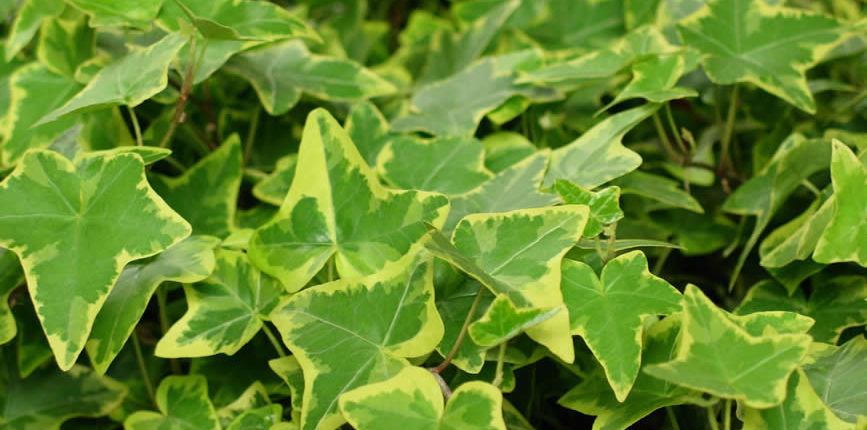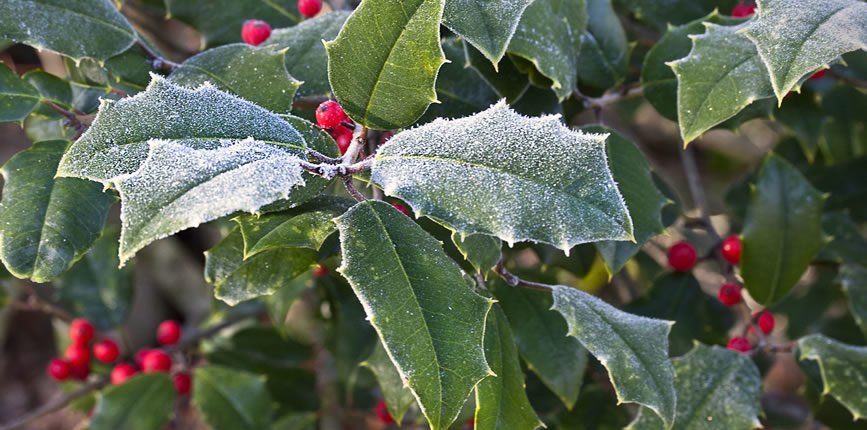The Holly & The Ivy – A Seasonal Blog Post

It may be seasonal, but I have to say that Ivy (Hedera) is not my favourite plant.
It can be rampant, grows almost anywhere, smothering other plants, and even managing to grow towards the dark, a feat not managed by other plants. It can be particularly damaging to brickwork pointing, which is why I never plant Ivy to grow up a house wall.
The jury is still out as to whether Ivy damages the trees it clambers up, but it definitely does make trees more likely to be damaged by strong winter winds – at a time when they would normally be bare, the Ivy provides a large green surface area for the wind to buffet.

Having said all this, Ivy isn’t always bad. There are some dainty pretty varieties, such as Gold Child, Green Ripple, Buttercup, Glacier etc, which are useful climbers for shady places (but not house walls!). Scrambling into the branches of a dead tree, Ivy can make a the tree almost appear to come alive again, and Ivy – pruned annually (in December) – can make a lush green hedge when grown up a fence. For wildlife lovers, Ivy provides a des res for nesting birds like wrens, robins and blackbirds, and its very late flowers provide a useful late source of food for insects. So, maybe not my favourite plant, but grown with care, potentially a very useful one.
Holly on the other hand…

In contrast, Holly (Ilex) is a plant I am particularly fond of. Like Ivy, it is very happy in shade (being a native woodland plant). It has a naturally tailored, almost pillar like shape (albeit a bit jaggedy) and comes in a variety of leaf and berry colours. It makes a lovely corner piece (and full stop) in a shady spot, where it will associate well with Mahonias, Pyracanthas, Winter Jasmine, Cotoneasters, Rhamnus, ferns etc to give a garden some wonderful winter (and largely evergreen) colour.
I especially like to use the x altaclarensis varieties such as Golden King (female despite its name), Lawsoniana and Belgica Aurea, which are beautiful plants with red berries and variegated leaves, which are less spiny leaves than other forms of Holly. Of the Ilex aquifolium varieties, Argentea Marginata (silver variegated leaves), Bacciflava (yellow berries) and Handsworth New Silver are all super plants, and there are many more. Also worth considering are the deep blue green leaves of Ilex meserveae cultivars.
Holly varieties are either male or female, with only female varieties bearing berries. Once established, they are tolerant of a wide range of conditions, but are happier with a bit of shade, rather than being in full burning sun. They are slow growing, so if you are considering buying a large specimen, it will be expensive. And while they are generally tolerant of dry conditions, newly planted specimens (with a large root ball) do not like being allowed to dry out completely – they will respond to this by dropping their leaves – and whilst they will recover, being a slow grower, the recovery can take some time.
But being a slow grower also means that they are very low maintenance plants, only really needing pruning to remove any misshapen limbs if you feel so inclined – which in this busy world, makes them a very desirable plant indeed. Of all the trees that are in the wood, they definitely bear the crown in my opinion.